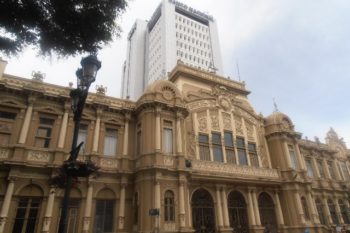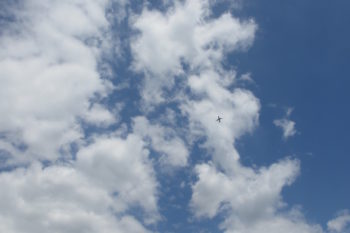Excitement. Tiredness. Astonishment. Those words describe my journey to Chirripó. Climbing the highest mountain in Costa Rica, with an altitude of 3,820 meters, is something I longed for my entire life, and I can dare to affirm it is in every Costa Rican’s adventurous soul.

Los Crestone seen from far away
The Chirripó National Park is located in the Talamanca Mountain Range and covers part of the provinces of San José, Cartago and Limón. It has a surface area of 50,150 hectares and it is part of La Amistad Biosphere Reserve, which was declared World Heritage Site by UNESCO in 1983. The word Chirripó has an indigenous origin meaning land of eternal waters, making reference to the numerous lagoons and rivers found in the area.

Lago Chirripó, the highest lake in Central America
The hike covers 14 kilometers between San Gerardo de Rivas (1,400m above sea level) and the El Páramo Environment Center (3,400m above sea level), where the visitor’s shelter is found. The ascent of 2,000 meters usually takes an average of 7-9 hours, but it could take more depending on the physical condition of the hiker and the pace maintained.
As hikers start their journey and continue through it, they find an incredible variety in nature: pastures, coffee plantations, oak forests, the alpine rain páramo, valleys, rock formations and glacial lakes. The flora found in the park include mosses, mushrooms, lichens and ferns, among others; examples of the fauna seen are birds, lizards, mammals such as rabbits, peccaries and even coyotes.

Beautiful trail

Arriving to the shelter
There are seven ecologically and geologically important areas of great landscape beauty: Cerro Chirripó, Los Crestones, Valle de los Conejos, Sabana de los Leones, Valle de las Morrenas, Cerro Ventisqueros and Valle de los Lagos.
Los Crestones are marvelous rock formations which are the National Park’s symbol and which was a sacred place for indigenous people.
The Cerro Chirripó is the fourth highest mountain of Central America and the world’s highest between two oceans. Half of the territory of Costa Rica can be seen from its summit in one glance, and on clear days, it is possible to see the Pacific and the Caribbean coasts as well as the Turrialba, Irazu and Poas Volcanoes.

Los Crestones, the National Park’s symbol
Walking the endless steep trails while gasping for breath, or freezing at the summit of Cerro Chirripó and while sleeping at the shelter represent a real physical and mental challenge. However, no words can describe the feeling of satisfaction, pride, happiness and peace that is experienced while climbing this mountain, especially when reaching the top.

The shelter seen from Los Crestones
The landscape this National Park offers is simply extraordinary; every single detail can take your breath away: tall trees touching the sky, a perfect colorful mushroom, dewdrops in plants and flowers, the profound silence around you… There is positive energy all around this place; there is magic. Many times during my journey, I wished I could contemplate the amazing landscape of nature forever.

Twin mushrooms

Colorful flowers
It is pretty easy to feel how immense the planet is and how small the human being is when observing around. It is pretty easy to become enchanted by this wonderful place while exploring your own spirit. Undertaking the intense adventure of climbing the highest peak in Costa Rica is a once in a lifetime experience that will definitely change your life forever. Wanna know what it feels like? Don’t wait any longer…Chirripó awaits you!

Chirripó rocks!
Read more:
Costa Rica’s beach paradise
Celebrating peace and freedom in Costa Rica
Qoyllur Rit’i – a Peruvian celebration high in the Andes





This sounds like an amazing experience. And the views look amazing. Did you sleep overnight in the shelter?
It is indeed an amazing experience Lucy! 🙂 Yes, I slept overnight in the shelter, you can only stay 2 nights there because there are always so many visitors..and it’s the only place in Costa Rica where you can experience a below-zero temperature (and it is during summer)! lol 😉 Actually, the lowest recorded temperature in Chirripó and, therefore, in the country, has been 9 degrees below zero!! Cool, huh?!
A cool post ! I never knew it could be so cold, anywhere in Costa Rica !
congrats on your adventure, Nuria!
Beautiful pictures!! I gotta climb the Chirripó some day too 🙂
Nuria, through your physical and engaging interactions and fantastic writing, you’ve left a desirable mark in me as a true Ambassador of your very beautiful and enhanting country. Next time I am in Costa Rica, I’ll dare to take advantage of some of the outdoor opportunities. I love adventure. Thanks Nuria for your friendship and for sharing a piece of Costa Rica.
Siempre todo lo mejor.
@Mike: Lol! Most people would never imagine it can get so cold in Costa Rica! jeje 🙂
@Rebeca: Thanks a lot!!
@Manolito: Gracias amigo! You need to come visit me and then we’ll climb it together 😉
@Dr. Mike: Thank you so much!! You definitely need to experience some adventure next time you come to Costa Rica, there are so many options out there. We’ll take you wherever you want 😀 Thanks for your friendship as well!
Hi there!!!
You look very happy in the last pic!!!
This post is cool…I Just have a question!
Do you take all the pictures? Because if it was you, I have to congratulate you, are excellent….
Go on!!!
Jijiji Thanks Johan! Yes, I took all the pictures! 😀 You know I love photography, so I really enjoyed climbing the Chirripó because every little detail can be an amazing picture 😉 And yes, I was really, really happy when I made it to the top lol It’s a wonderful feeling!!!
Great Article and pictures!
Hola Nuria! Que chiva que esta lo que escribio me siento muy orgullosa de mi hermanita! Te quiero mucho!
Awwhhh, muchas gracias Sil! 🙂 Yo también te quiero mucho big sis! <3